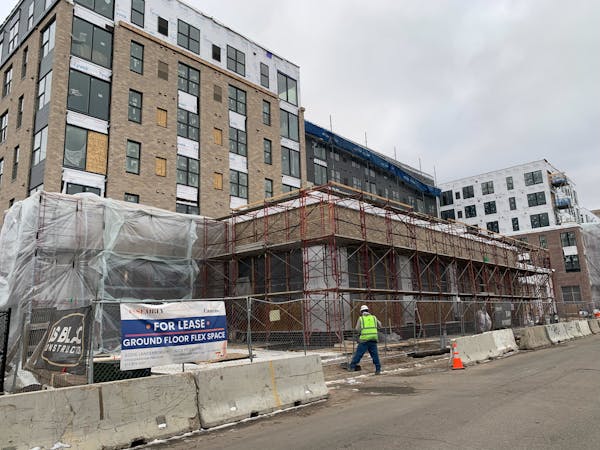After two hot years, apartment construction in the Twin Cities area will pull back this year as higher interest rates and a chill in commercial lending make financing such projects more difficult.
The first whiff of that shift came during the waning months of last year, when multifamily permits — an indicator of future construction — plummeted as apartment developers tightened the spigot on their development pipelines.
"The primary issue has been financing," said Mary Bujold, president of Maxfield Research. "But there's demand out there."
Although there are still too few apartments in parts of the metro, especially for lower-income renters, the slowdown comes after at least a couple of years of record construction created a glut of new rentals in some submarkets. That includes downtown Minneapolis and St. Louis Park, where some building owners are offering a month or two of free rent to help lease those buildings more quickly.
The Federal Reserve Bank of Minneapolis said a November survey that tracks business conditions for the construction industry found the residential sector was worsening by a "sizable margin" compared with other sectors. And during the Fed's recent Regional Economic Conditions Conference, Mortenson Construction Chairman David Mortenson said higher interest rates — not lack of demand — had stifled apartment construction.
"We've got a number of pieces of land that we're trying to do multifamily on, and we need rates to come down another 100 basis points before we think they're viable," he said.
Apartment developers also face the same challenge vexing office owners. Like office loans, apartment debt is short term, requiring borrowers to refinance or modify their debt every few years.
When interest rates were near record lows two to three years ago, many building owners refinanced. Those loans are now coming due again, creating what some analysts call a tsunami of debt that will refinance at much higher rates and create even more uncertainty for lenders.
"I think we've seen a tremendous slowdown over the past year in construction starts, and I expect that to continue through 2024," said Robb Bader, chief development officer for Bader.
Bader completed several hundred new units last year, including a luxury apartment building called Waterbury House in the Uptown area of Minneapolis. He's optimistic that the long lead time on new projects will give the market time to absorb the thousands of units already under construction.
"The Twin Cities is in good shape to recover far quicker than many other metro areas," he said. "The units being delivered [today] have absorbed at a very healthy pace, and the supply will drastically decline toward the end of 2024 and beyond."
Interest rates up, construction costs down
Twin Cities developers said that while financing a project is more difficult, there are other aspects of the business that are improving. Early in the pandemic, builders and developers faced crippling shortages of labor and materials, along with record prices for both. That's no longer the case.
"Lending is the hardest part of our business, and that has required us to have more capital up front and work with partners and investors," said Roers Cos. owner and co-founder Brian Roers. "But as much as interest rates have gone up, construction costs have come down. That's been our offset."
At peak prices, the lumber cost on a project in Rosemount was estimated at about $3.7 million, said Kent Roers, the other half of the brotherly duo that founded and owns Roers. But in June, when the company closed on the project, that same lumber package cost $2.6 million.
"That drop is almost keeping up with the rise in interest rates," Kent Roers said.
The company has another competitive advantage because it is ordering more materials when others are ordering less, he said. That has enabled it to negotiate more favorable prices on materials and labor. The latter has been a significant hurdle for most employers in Minnesota, as the state's unemployment rate remains at 3.1% compared with a national rate of 3.7%.
A couple of years ago, he said, the company was having trouble garnering even one or two bids from critical subcontractors such as excavators. Today, it's receiving upward of 15 bids.
"Subs are coming to us and willing to do it at cost just to keep crews busy," Kent Roers said.
The increase in availability of labor is a sign that the number of multifamily units built in the metro area has peaked and should now fall. Bujold said that in 2023, more than 9,200 market-rate and income-restricted rentals finished in the seven-county metro area, not including thousands of age-restricted units. With permits to build multifamily buildings down in recent months, she expects only 8,177 completions this year and 3,000 in 2025.
A growing exception
While others retreat, Roers is expanding. The firm closed 16 deals last year and plans to build a minimum 20 more in 2024, including several projects in Florida, Texas and other states.
"With other developers not getting out of the ground, we think the opportunity gets better," Brian Roers said.
He said the company is uniquely positioned to press forward when others aren't since it can tap into what he calls a local network of "friends and family" investors who provide the kind of equity many developers can't raise. To help meet increasing equity requirements, the company has appealed to individual and local investors via an "investor hub" on its website.
The company also maintains a "vertically integrated" business model that allows it to control all aspects of the process by maintaining its own in-house development, construction, marketing and management teams. Brian Roers said this enables the company to fine-tune its operations.
"That's been our secret sauce from Day One," said Shane LaFave, a Roers executive vice president.
Roers isn't shying away from the suburbs, where it's now tackling several large projects. For years, downtown Minneapolis had been the epicenter of the apartment development boom. But as vacancy rates have risen, developers have increasingly focused on inner-ring suburbs. In the southwest suburbs — including St. Louis Park, Edina and Minnetonka — the vacancy rate for new buildings that are still in the initial lease-up phase has approached double digits.
In Plymouth, Roers and its development partner, Scannell, are planning to redevelop the former Prudential campus into a $250 million mixed-use development with medical office buildings and hundreds of apartment rentals. And in Maple Grove, the company is about to begin construction on a 150-unit, market-rate project on a redevelopment site another developer wasn't able to complete.
Pains for gains
Like Roers and some other developers, Minneapolis-based Schafer Richardson is proceeding cautiously but still expanding into other states to bolster its pipelines.
"We have quite a few in the hopper that we expected to close on in 2023," said Stefanie Sokup, marketing director for the company. "But with interest rates where they were, it was really hard to get a market-rate deal to pencil, along with the fact that capital sources for funding are hard to come by."
Sokup said the company has several projects queued up to close in 2024, including three market-rate projects and two income-restricted ones.
"It's a bit easier to close affordable deals right now because of tax credits," she said.
The company recently started pre-leasing a market-rate project in White Bear Lake, and the income-restricted building in St Paul should finish this spring.
Still, Sokup said the looming slowdown is probably good for the industry overall.
"We need some time to absorb the deliveries from the development boom two years ago, when interest rates were so low, so we can even things out a bit," she said. "This isn't always what developers want to hear, but it's necessary if we want to operate full buildings without offering deep concessions."
Minnesota's Fit Butters rode better-for-you food trend to $5M in sales in five years

Recessions are a normal part of how the economy ebbs and flows. How this time is different.

Chaska commercial bakery Apple Valley Foods closing, laying off 95

Suicide deaths have plateaued in Minnesota, slowing a two-decade climb



